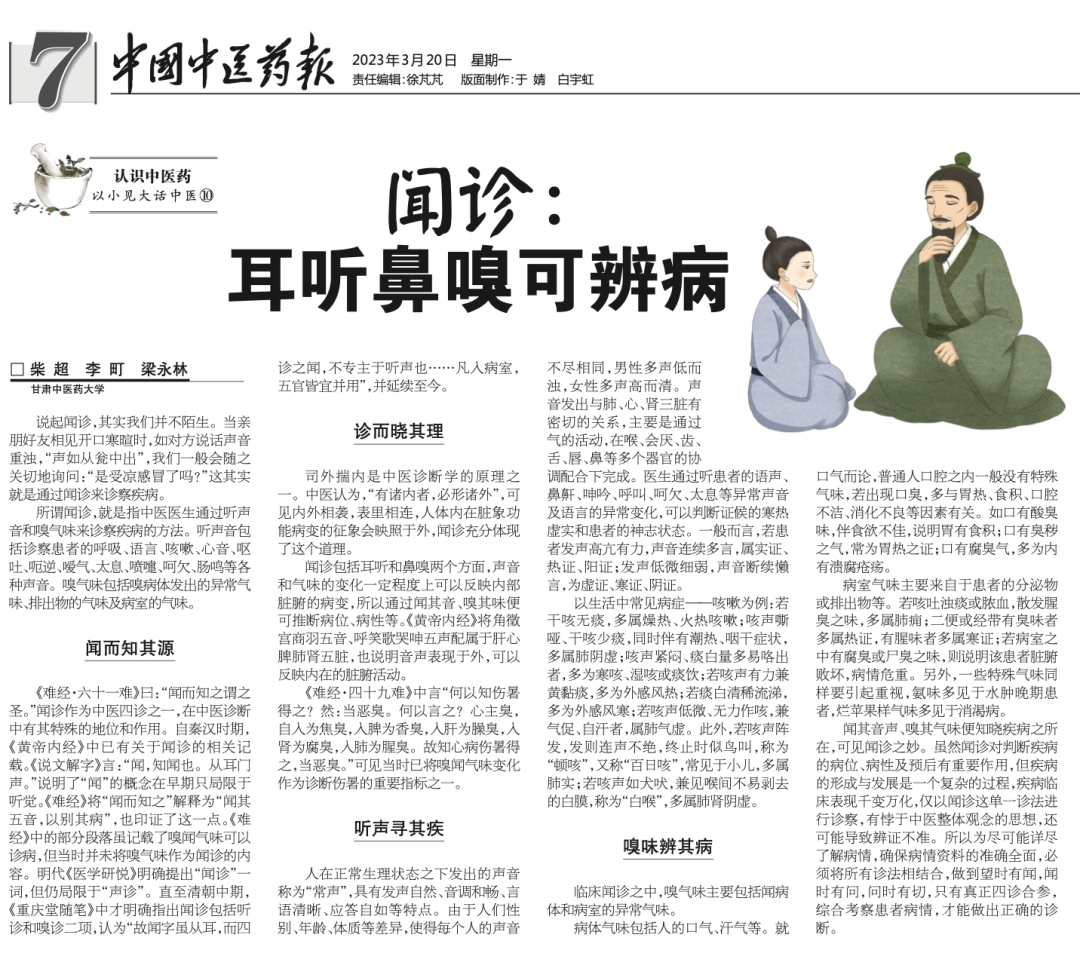 Click the above “Public Account” to subscribe!
Click the above “Public Account” to subscribe!
Source|China Traditional Chinese Medicine News
Written by|Gansu University of Chinese Medicine Chai Chao, Li Ting, Liang Yonglin

When it comes to ‘Wen Zhen’, we are not unfamiliar. When friends and family meet and greet, if one speaks with a heavy and muffled voice, “as if coming from a jar”, we often inquire with concern: “Have you caught a cold?” This is actually a form of diagnosis through ‘Wen Zhen’.
‘Wen Zhen’ refers to the method in Traditional Chinese Medicine (TCM) where practitioners diagnose diseases through listening to sounds and smelling odors. Listening includes assessing the patient’s breathing, speech, cough, heart sounds, vomiting, belching, sighing, sneezing, yawning, and bowel sounds. Smelling involves detecting abnormal odors from the body, excretions, and the environment of the patient.
Knowing the Source by Listening
The “Nanjing: Difficult Issues” states: “To know by listening is called a sage.” As one of the four diagnostic methods in TCM, ‘Wen Zhen’ holds a unique position and function in TCM diagnosis. Since the Qin and Han dynasties, there have been records regarding ‘Wen Zhen’ in the “Huangdi Neijing” (Yellow Emperor’s Inner Canon). The “Shuowen Jiezi” states: “Wen means to know by hearing. It comes from the ear and sound.” This indicates that the concept of ‘Wen’ was initially limited to auditory perception. The ‘Nanjing’ explains “to know by listening” as “to hear the five sounds to differentiate diseases”, confirming this point. Although some passages in the ‘Nanjing’ recorded that smelling odors could diagnose diseases, it did not include olfactory diagnosis as part of ‘Wen Zhen’ at that time. The Ming dynasty’s “Yixue Yanyue” explicitly proposed the term ‘Wen Zhen’, but it was still limited to auditory diagnosis. It was not until the mid-Qing dynasty that the “Chongqing Tang Suibi” clearly stated that ‘Wen Zhen’ includes both auditory and olfactory diagnosis, asserting that “although the character for ‘Wen’ comes from the ear, the ‘Wen’ in the four examinations is not solely focused on hearing… All five senses should be used when entering the patient’s room”, a practice that continues to this day.
Diagnosing and Understanding the Principles
External Signs Reflect Internal Conditions is one of the principles of TCM diagnosis. TCM believes that “what is within must manifest externally”, indicating that internal and external conditions are interconnected. The signs of internal organ dysfunction will reflect externally, and ‘Wen Zhen’ fully embodies this principle.
‘Wen Zhen’ includes hearing and smelling, where changes in sound and odor can reflect internal organ diseases to some extent. Thus, by listening to sounds and smelling odors, one can infer the location and nature of the disease. The “Huangdi Neijing” associates the five sounds (角, 徵, 宫, 商, 羽) and the five voices (呼, 笑, 歌, 哭, 呻) with the five organs (liver, heart, spleen, lung, kidney), indicating that external sounds can reflect internal organ activities.
In the “Nanjing: Difficult Issues”, it states, “How do we know it is caused by summer heat? It is due to foul odor. How do we say this? The heart governs odor; it produces a burnt smell when affected, a fragrant smell in the spleen, a rancid smell in the liver, a putrid smell in the kidney, and a fishy smell in the lung. Thus, we know that heart disease caused by summer heat will have a foul odor.” This shows that at that time, changes in odor were already considered an important indicator for diagnosing summer heat.
Listening for the Disease
Sounds produced by a person in a normal physiological state are called “normal sounds”, characterized by natural vocalization, harmonious tone, clear speech, and responsive communication. Due to differences in gender, age, and constitution, each person’s voice varies; men typically have deeper and muddier voices, while women often have higher and clearer voices. The production of sound is closely related to the lungs, heart, and kidneys, primarily completed through the coordination of various organs such as the throat, epiglottis, teeth, tongue, lips, and nose. By listening to the patient’s voice, snoring, moaning, calling, yawning, and sighing, as well as any abnormal changes in speech, doctors can assess the cold-heat, deficiency-excess, and mental state of the patient. Generally, if the patient’s voice is loud and strong, speaking continuously, it indicates excess, heat, or yang conditions; if the voice is weak and intermittent, it suggests deficiency, cold, or yin conditions.
Taking a common ailment like cough as an example: if the cough is dry and non-productive, it often indicates dryness-heat or fire-heat cough; if the cough is hoarse and dry with little phlegm, accompanied by tidal fever and dry throat, it often indicates lung yin deficiency; if the cough is tight and produces a lot of white phlegm that is easy to expel, it often indicates cold cough, damp cough, or phlegm retention; if the cough is strong with yellow sticky phlegm, it often indicates external wind-heat; if the phlegm is white, clear, and watery, it often indicates external wind-cold; if the cough is weak and ineffective, accompanied by shortness of breath and spontaneous sweating, it indicates lung qi deficiency. Additionally, if the cough is paroxysmal, continuous, and ends with a sound like a bird call, it is called “duan ke” (whooping cough), commonly seen in children, often indicating lung excess; if the cough sounds like a dog barking, accompanied by a difficult-to-remove white membrane in the throat, it is called “bai hou” (diphtheria), often indicating lung and kidney yin deficiency.
Distinguishing Disease by Smell
In clinical ‘Wen Zhen’, olfactory diagnosis mainly includes detecting abnormal odors from the body and the environment.
Body odors include bad breath and sweat. In terms of bad breath, a normal mouth generally does not have a special odor; if there is halitosis, it is often related to stomach heat, food retention, poor oral hygiene, or indigestion. For example, if there is a sour odor in the mouth, accompanied by poor appetite, it indicates food retention in the stomach; a foul odor often indicates stomach heat; a putrid odor often indicates internal ulcers or sores.
Environmental odors mainly come from the patient’s secretions or excretions. If the patient coughs up turbid phlegm or pus with a foul odor, it often indicates lung abscess; if the urine or stool has a foul odor, it often indicates heat conditions, while a fishy odor often indicates cold conditions; if the environment has a putrid or cadaveric smell, it indicates severe internal organ failure and critical condition. Additionally, some special odors should also be noted; for example, ammonia odor is often seen in late-stage edema patients, and a rotten apple-like smell is often seen in diabetes.
By listening to sounds and smelling odors, one can discern the location of the disease, showcasing the brilliance of ‘Wen Zhen’. Although ‘Wen Zhen’ plays an important role in determining the location, nature, and prognosis of diseases, the formation and development of diseases is a complex process, and clinical manifestations can vary widely. Relying solely on ‘Wen Zhen’ for diagnosis contradicts the holistic view of TCM and may lead to misdiagnosis. Therefore, to thoroughly understand the patient’s condition and ensure accurate and comprehensive data, all diagnostic methods must be combined, achieving a balance of observation, listening, inquiry, and palpation. Only through a comprehensive examination of the patient’s condition can a correct diagnosis be made.
The China Traditional Chinese Medicine News has launched an official Douyin account!Welcome to follow us!!Open Douyin and search for “China Traditional Chinese Medicine News”Douyin ID: 36254766218
Editor|Wang Qingyun
Reviewed by丨Wang Shujun Li Rui


